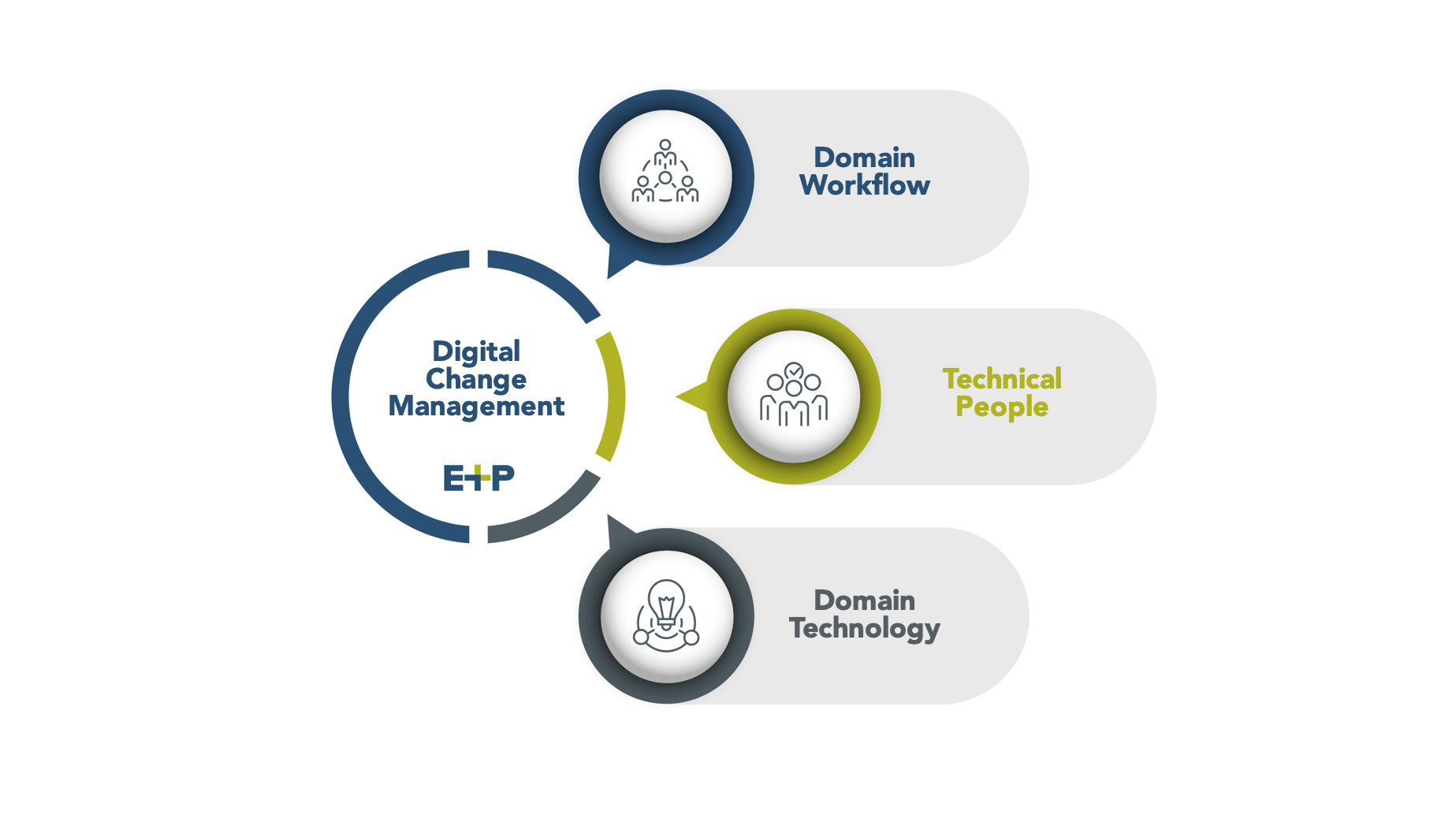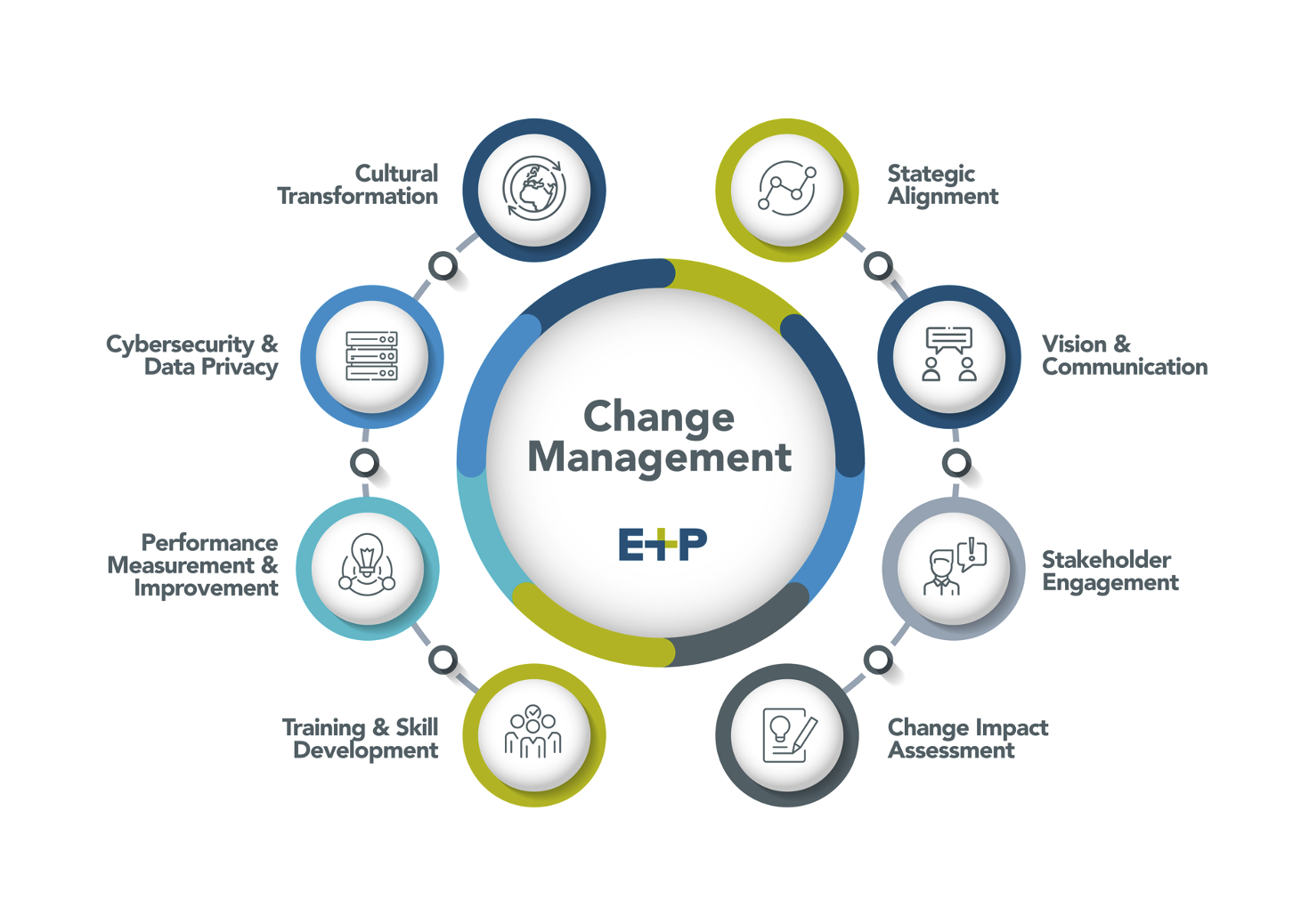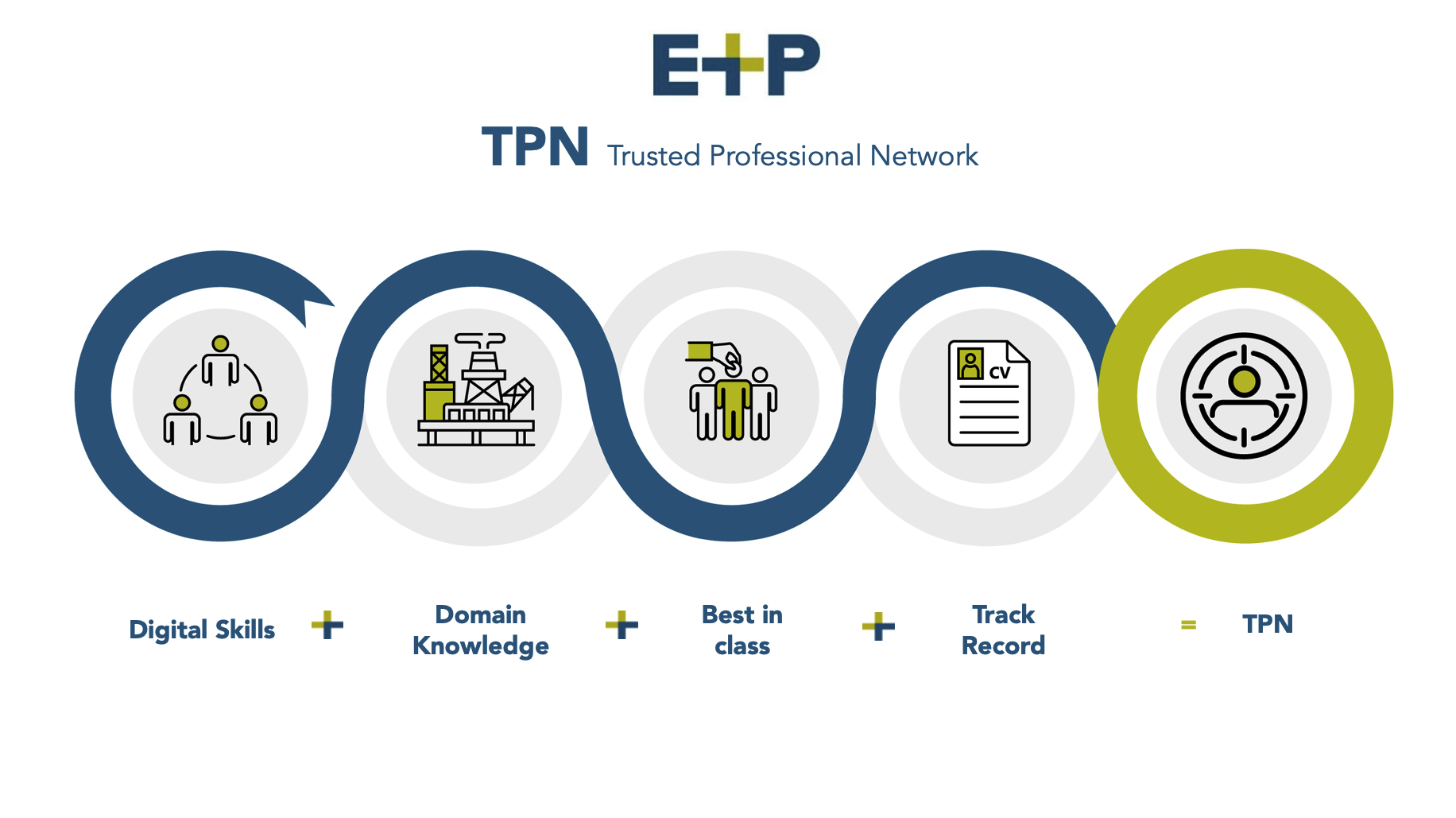Optimising Change Management with a Domain Contextual Approach
31 May 2024 — E&P - Ian Kennedy & Wilson Rincon

This feature article is the first in a series of articles on change management and design thinking from the team at E&P Consulting. This latest article aims to explore the role of change management in the successful delivery of digital projects within oil and gas companies, and how the end-to-end process can be more effective with a domain contextual approach.
For any digital project, change management is vital to ensuring the full potential of new and transformative technologies is realised. As companies transition to new digital systems and processes, effective planning, implementation, and management of the process will play a critical role in achieving optimal results. However, the oil and gas industry has often struggled to maximise the value of its digital initiatives. A significant factor contributing to this is the use of non-contextual change teams or individuals.
The oil and gas value chain, along with its systems and workflows, is highly complex, and a generic change management approach has proven to be insufficient. Context and domain understanding are essential to ensure that goals and concepts are effectively framed and communicated. Bridging the gap between business and digital is crucial, and credibility and understanding must flow in both directions.
So, what should be considered when taking a domain contextual approach to change management?
The role of change management in the oil and gas industry
Digital transformation in the oil and gas industry aims to streamline operations, bolster safety, cut expenses, and refine decision-making using tools like AI, IoT, big data analysis, and automation. Change management involves addressing the specific hurdles of implementing these new technologies in a sector that is characterised by complexity, regulatory requirements, caution, and adherence to legacy methods, data systems, and processes.
As an example, wells organisations have often failed to fully realise the value of real-time systems and data generated during drilling operations. The data and corresponding visualisations are frequently viewed as merely supplementary to the operations phase, rather than being leveraged as essential tools for decision-making and analytics. This underutilisation of data means missed opportunities for optimising drilling performance, enhancing safety, and reducing costs.

In addition, one of the primary challenges is underestimating the extent of change required to integrate these systems effectively. If there is a lack of unified vision to bring key elements of digital (IT and telecoms), domain expertise (wells), and third parties (service companies and partners) together, the approach will be fragmented This can result in silos, where each group works in isolation without a cohesive strategy that aligns with the overall objectives of the organisation.
Critical roles of contracts and procurement may be overlooked in these initiatives. Properly stipulating the terms and penalties associated with the type, quality, and frequency of data needed from third parties is essential. Without clear contractual obligations, there may be inconsistencies in data delivery and quality, which will undermine the entire digital initiative.
Whilst change management will make a significant difference in these complex scenarios, generic change management approaches often fail to address the specific needs and challenges of wells operations. In this context, understanding the intricacies of drilling processes, the importance of real-time data, and the operational challenges is crucial. This domain expertise ensures that change management strategies are relevant and effective.
Choosing the right digital change management strategy
For oil and gas companies, the focus and approach of the change manager will be decided by the needs of the digital project, as well as the overall goals to be achieved. Three key areas that the digital change manager should be focused on include Domain Workflow, Technical People, and Domain Technology.

The right change management approach to drive value in these three key areas requires the organisation to first identify the type of change needed and the potential scenarios to be managed. The change manager can then put effective strategies and plans in place to successfully transition digital initiatives from the current position to the desired future position.
As domain systems and data integrators (SDI), we help companies in the energy industry to improve workflows and insights by taking a unified view across data and applications. This approach, supported by established and new processes and technology, ensures companies have access to dependable information for smarter decisions and better results.
Four change management approaches to consider in a project scenario include Operational, Cultural, Technical, and People-centric.
1) Operational Change Management
This approach is focused on the implementation of new technologies to improve operational efficiency and productivity. This is useful in situations where businesses aim to streamline processes, reduce costs, or enhance service delivery through digital solutions like ERP systems or AI-driven tools.
Example: Predictive Maintenance: The adoption of Machine learning models to predict equipment failures before they occur by analysing historical data and identifying patterns that precede breakdowns. This allows for timely maintenance and reduces downtime.
2) Cultural Change Management
This approach is focused on addressing and modifying the organisational culture to embrace digital change. This is most important in scenarios where there is resistance to digital tools or processes, requiring efforts to shift mindsets and norms within the organisation.
Example: Applications and Data Champions: Appointing digital champions within upstream domain disciplines responsible for driving the digital transformation agenda. These leaders communicated the importance of digital technologies and set clear digital goals for the organisation.
3) Technical Change Management
This approach is focused on the actual rollout and technical implementation of new digital tools or platforms. This is essential when introducing new software, hardware, or IT systems, ensuring that the technical deployment is smooth and that technical issues are addressed quickly.
Example: Technology Evaluation: Wells IT organisations examining multiple digital twin platforms and technologies, considering factors such as scalability, compatibility with existing systems, and ease of integration. Vendor demonstrations and pilot tests helped in selecting the most suitable technology.
4) People-centric Change Management
This approach is focused on the human side of change, ensuring that employees are ready, willing, and able to use new technologies. This is crucial in all digital transformation projects, but especially in those that significantly alter day-to-day work practices.
Example: Inclusive Planning: Integrating AI for site safety monitoring at refineries by Involving key stakeholders, including safety officers, operations managers, and frontline workers in the planning and decision-making process. Ensuring the system addressed real-world safety challenges and gained early support.
Summary
By integrating change management expertise with a deep understanding of digital domains, the best-fit approach can be adopted for each digital project in the context of the energy industry. Operational disruptions, employee resistance, and financial impacts can then be predicted, planned for, and more effectively managed and mitigated.
E&P Consulting’s eight critical steps for effective change management
Once the right change management approach has been decided, the agreed strategy and plans to drive the digital project forward can be started. To mitigate risk, each step in the digital transformation journey must be carefully managed, from the first step of strategic alignment, where digital projects are matched with the company's main goals, through to stakeholder management, change impact assessments, and cultural transformation.

- Step 1 - Strategic Alignment: Change management should always start with matching digital projects with the company's main goals. Identify key drivers like boosting efficiency, cutting downtime, improving safety, or promoting sustainability, and make sure digital efforts target these priorities.
- Step 2 - Vision and Communication: It's also crucial to create an inspiring vision for the digital transformation journey to garner support and enthusiasm from employees and stakeholders. Clear communication of the vision, goals, and benefits helps to generate excitement, build momentum, and address concerns about the upcoming changes.
- Step 3 - Stakeholder Engagement: Engaging stakeholders from the start and keeping them involved is vital to gain their backing, handle worries, and use their know-how. Stakeholders in energy digital projects could be top executives, operational workers, IT experts, regulators, suppliers, and external collaborators. By involving them in decisions, seeking their input, and offering chances to work together, you foster a feeling of ownership and boost the adoption of digital solutions.
- Step 4 - Change Impact Assessment: Before launching digital initiatives, it’s important to evaluate how they might affect people, processes, and systems to prepare for challenges and plan solutions. This includes identifying affected stakeholders, examining current workflows and job roles, determining training requirements, and gauging existing systems' readiness to adopt new technologies. This analysis guides the creation of customised change management plans tailored to the project's needs.
- Step 5 - Training and Skill Development: As digital transformation progresses; employees often need new skills to use and support new technologies. Offering various training programs tailored to different user groups boosts confidence and enthusiasm for digital tools and processes.
- Step 6 - Performance Measurement and Continuous Improvement: To gauge the success of digital projects, set up KPIs and metrics to track their impact and pinpoint areas to enhance. Regular reviews, audits, and user feedback loops can help to assess change management effectiveness and guide future decisions. Continuous improvement means continually refining processes, heeding user feedback, and adjusting to changing business requirements and technology advancements.
- Step 7 - Cybersecurity and Data Privacy: Digital changes bring new risks, especially in energy, where operational and IT systems are linked. Change management must include strong cybersecurity measures like access controls, encryption, and threat detection to protect infrastructure and data. Compliance with regulations like NIST Cybersecurity Framework, ISO 27001, and GDPR is crucial for avoiding legal and reputational harm from data breaches and cyberattacks.
- Step 8 - Cultural Transformation: Digital transformation isn't just about technology—it's about fostering a culture that values agility, teamwork, and creativity. Change management should promote a culture that welcomes experimentation, sees failure as a chance to learn, and encourages collaboration across teams.
A tailored and comprehensive approach that incorporates domain expertise, combined with robust change management practices, will drive better decision-making, enhance operational efficiency, and ultimately, create more project value for the energy organisation.
The role of product assurance in digital change management projects
The importance of domain understanding in change management cannot be overstated. It is at least as important, if not more so, than the methodology or approach used. As products supporting the Upstream business can vary significantly in profile, it is important to assess each product in detail to determine the required focus, the project needs, and the right team structure.
When building a Product Team, the outcome of the product analysis can be used to identify key skills and their importance. This helps ensure the team has the optimal resource profile, giving it the best chance of success and value realisation during change management.

Once the product, approach, and team dynamics have been decided, the next step is selecting professionals to support and deliver the digital energy projects. However, contracts can vary, and companies are changing how they engage resources for different delivery methods, such as agile squads and high-performing teams.
However, with fewer newcomers and an increasing number of retirees in the industry, the talent pool is narrowing. Projections indicate a potential 40% reduction in skilled professionals over the next decade. The surging demand for domain-skilled digital professionals in the energy industry is increasing the pressure on the limited market for digital-domain talent, focusing on quality, cost, and experience. Traditional ways of getting resources are not enough to ease this pressure.
E&P’s approach to change management: Your Framework, Our People
Managing change in energy digital projects is inherently complex, demanding companies to collectively consider technical, organisational, and cultural factors. In addition to applying a tailored and comprehensive approach to change management, our experience has shown that change management can significantly impact the success of digital initiatives when domain-specific skills are applied.
Utilising E&P’s change management solutions as part of our wider product assurance approach enables us to combine domain knowledge with experience in the digital sphere, ensuring that our clients achieve effective change management and realise their digital and data aspirations.
To deliver on this, E&P established Trusted Professional Network (TPN), which guarantees access to a highly skilled talent pool that best fits a company’s product vision.
The four core pillars of E&P’s Trusted Professional Network include:
- Active rather than passive engagement with resources
- International reach: onshore and offshore
- Pre-qualification and preselection
- Quick turn around

TPN allows us to provide access to talented teams of digital domain experts, led by digital change managers who understand the complex operations and demands of today’s energy landscape.
By linking digital plans with business goals, involving stakeholders, empowering staff, and promoting innovation and adaptability, we ensure that energy companies deliver their strategic digital transformation goals and can continue to thrive in a changing industry.
Our hubs in America, EMEA, and Asia support our global clients by providing access to talent worldwide. These locations serve as central points for leveraging diverse skills and expertise. Through this global network, we ensure effective support and collaboration for our clients across different regions, simplifying their international operations.
If you would like to learn more about our domain contextual change management solutions and the consultancy services and skills that we provide for integrated energy organisations, contact us today.
___
Authors:
Ian Kennedy - Head of Oil and Gas
As E&P's Head of Oil and Gas, Ian is responsible for developing and promoting E&P's consulting services, ensuring that value is realised from digital technologies within oil and gas organisations. Ian has over 25 years of experience working with major oil, gas, and service companies and leading systems integrators to optimise the use of information technology. His passion is applying the appropriate mix of people, processes, and technology to solve industry challenges.
Wilson Rincon - Operations Lead, E&P Consulting
As E&P's Operations Lead, Wilson is responsible for establishing a seamless operation at E&P where the teams can focus on excellence, value generation to clients, and the pursuit of continuous growth, while working with the client's organisation to implement sound contractual and financial models to benefit the partnership. Wilson has over 28 years of experience in the energy industry, having started his career developing applications for oil and gas organisations, specifically in drilling and production. He soon moved into leadership roles, including servicing customers in the oil and gas industry in a variety of engagements and models globally.



